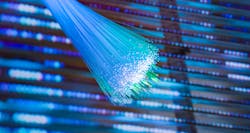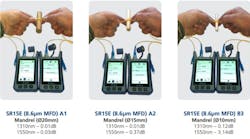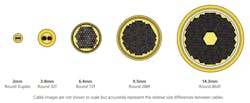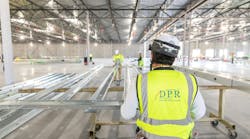Single-Mode Fiber Bend Performance in Data Center Networks
The bending performance of a fiber optic strand of glass is somewhat paradoxical – one might assume bending a very fine strand of pure glass would result in breakage. Very thin glass is surprisingly flexible. A specialized plastic coating further protects the glass against very tight bending and damage. This article addresses the bending performance of single-mode fiber within hyperscale and AI data center environments operating at a 1310 nm wavelength. Additionally, the discussion clarifies fiber standards, bending performance, and the implications of Mode Field Diameter (MFD) on bending.
Data centers predominantly utilize optical networks operating at 1310 nm. This wavelength is optimal due to near-zero chromatic dispersion, significantly simplifying transceiver design, reducing complexity and costs. Consequently, data centers will continue utilizing 1310 nm transceivers for the foreseeable future. Standards-compliant single-mode fibers, particularly ITU-T G.652.D, inherently exhibit excellent bend performance at 1310 nm.
The Telecommunication Standardization Sector of the International Telecommunications Union (ITU-T) provides two primary standards pertinent to single-mode fiber:
- ITU-T G.652 specifies geometric, mechanical, and transmission characteristics. G.652.D fibers are recognized industry-wide for high bit-rate data center applications.
- ITU-T G.657 covers enhanced macrobend performance fibers, primarily at telecom wavelengths (1550 nm and 1625 nm) aimed at Fiber-to-the-Home (FTTH) installations. Notably, G.657 does not address macrobend performance at 1310 nm wavelengths, as good bend performance at this wavelength is already achieved by standard G.652.D fibers.
A critical factor influencing fiber bend performance is the fiber core. MFD increases with wavelength, directly influencing bend sensitivity. Smaller MFD fibers (around 8.6 µm at 1310 nm) exhibit superior bend performance ideal for short-to-medium distances within data centers, supporting dense cabling environments. Larger MFD fibers (around 9.2 µm) are optimized for lower attenuation in long-haul telecommunications but are notably more sensitive to bending at longer wavelengths, irrelevant to data center applications.
FTTH networks typically operate at longer wavelengths (1550 nm and above) where fibers are very sensitive to bending losses, due to this sensitivity, enhanced bend performance fibers (G.657.A2 or G.657.B3) are deployed in environments where multiple tight bends are likely (e.g., inside buildings or apartments) requiring highly bend-insensitive fibers (G.657.A2 or G.657.B3). Such fibers feature specialized core and cladding structures, significantly increasing manufacturing complexity and cost, which is unnecessary for data centers operating exclusively at 1310 nm.
In practice, fiber bending performance tests demonstrate negligible macrobend losses at 1310 nm. For instance, Fujikura's SR15E fiber, which has an MFD of 8.6 µm, exemplifies outstanding bend performance. Tests conducted with SR15E fiber patch cords show near-zero additional attenuation at challenging bend radii:
- At a 10 mm radius (A1 equivalent), attenuation increase was measured as 0.01 dB.
- At a 7.5 mm radius (A2 equivalent), attenuation increase was also 0.01 dB.
- At a stringent 5 mm radius (B3 equivalent), the attenuation increase was still minimal at 0.12 dB.
This clearly demonstrates that SR15E fiber exceeds the equivalent bend performance specified by the ITU-T G.657.A1, A2 & B3 standard at the data center wavelength of 1310 nm.
Comparable tests conducted at 1550 nm for the same fiber showed increased losses while still meeting the bend performance requirements of G.657.A1 & A2. This further emphasizes that stringent telecom bend standards at 1550 nm are irrelevant to data centers operating at 1310 nm. Competitor fibers with larger MFD (9.2 µm) showed higher bend-induced attenuation at tighter radii, reinforcing the advantage of smaller MFD fibers for data center environments.
Importantly, fiber is always installed within cables, and the cable structure inherently limits bending. Typical data center cables have high fiber counts, creating stiff constructions that cannot physically achieve the small bend radii outlined by G.657 standards without damage. Consequently, cable bend radius specifications in data centers, typically around ten times the cable diameter, inherently prevent extreme bending.
Common misunderstandings and misinformation suggesting that enhanced bend-insensitive fibers (e.g., G.657.A2 or B3) are necessary for data center applications results in unnecessary over-specification, increased complexity, and inflated costs. Fiber specifications intended for telecom or FTTH applications at longer wavelengths have inadvertently influenced perceptions about data center requirements.
Standard G.652.D/G.657.A1 compliant fiber, exemplified by Fujikura SR15E, is entirely sufficient for data center networks operating at 1310 nm, including high-density, high-volume AI applications. SR-15E achieves A1, A2 and B3 equivalent macrobend performance at 1310 nm. Current standards and industry developments reflect a continued commitment to 1310 nm solutions in the data center. For instance, IEEE 802.3dj and Ethernet Alliance activities focus exclusively on next-generation O-Band (1310 nm) solutions for data rates of 800 G and 1.6 TB, confirming sustained industry reliance on 1310 nm wavelengths in the data center.
In summary:
- Data center optical networks will continue to rely on 1310 nm for optimal cost, dispersion performance, and operational simplicity.
- All standard G.652.D fibers inherently offer sufficient bend performance at 1310 nm.
- Smaller MFD fibers (e.g., Fujikura SR15E) provide excellent bend resilience suited to data center demands.
- Fiber cable structures inherently limit bending, ensuring additional protection.
- Misinformation advocating enhanced bend-insensitive fibers, relevant only at telecom wavelengths, unnecessarily inflates specifications and costs in data center applications.
Understanding these critical points ensures practical, cost-effective, and technically sound fiber selection for data center networks.
For more detailed information, please see the full white paper from AFL: Single-Mode Fiber Bend Requirements in the Data Center White Paper
About the Author

Alan Keizer
Dr. Alan Keizer is Senior Technical Advisor for AFL Hyperscale. Alan earned a Ph.D. in Physics from Cornell University and has worked at the intersection of computers and networking for the past four decades. He has been an individual technologist, a business development leader and senior executive. Joining FibreFab in 2006, he was a key contributor to the business which was acquired by AFL Telecommunications in 2013 and became a key component of today’s AFL Hyperscale. Since 2010, his main focus has been development of optical fiber connectivity solutions for hyperscale computing.

Keith Sullivan
Keith Sullivan is the Director of Strategic Innovation for Hyperscale, AFL. With over 30 years of experience, Keith is an accomplished business leader in the fiber optics industry with a specialty in data centers. He started his career in 1995 in a factory in England producing specialty fiber assemblies for high-speed devices in the telecom industry. Since then, he has worked for industry-leading organizations in sales, marketing, product line management, and strategy.






